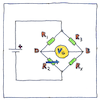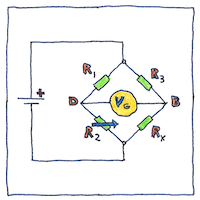Samuel Hunter Christie,
Charles Wheatstone
electromagnetism

|
Wheatstone bridge
To measure resistance Rx, adjust the resistance R2 until the voltage between the two midpoints (B and D) is zero and no current flows through the galvanometer Vg. You can calculate the unknown resistance Rx because the ratio of the resistances in the known leg ( R2 / R1 ) is equal to the ratio of the resistances in the unknown leg ( Rx / R3).
Christie bridge
Samuel Hunter Christie invented it but Charles Wheatstone popularized it as though that was what mattered.
Other bridges
Carey Foster bridge, to measure low resistances. Kelvin bridge, to measure four-terminal resistances. Maxwell bridge, to measure inductances. Diode bridge, also known as Graetz bridge, doesn’t measure anything. Tower Bridge, not the real London Bridge. Brooklyn Bridge, made famous by Hart Crane and not for sale. Tacoma Narrows Bridge, originally known as Galloping Gertie. Golden Gate Bridge whose cables contain 27,572 wires.



Only a handful of years after the definition of Ohms law (establishing the relation between voltage, current, and resistance), scientists created the first useful circuits that took advantage of this knowledge. Wheatstone bridges were first used for analyzing soils.
See also in The book of science:
Readings in wikipedia: